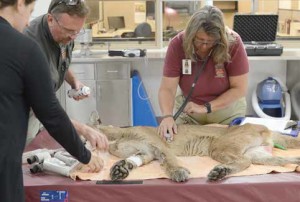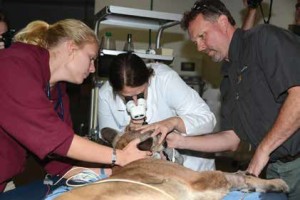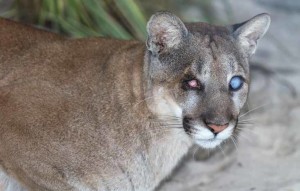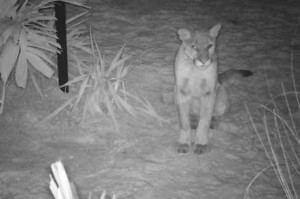YOUNG PANTHER BLINDED BY SHOTGUN TO BE FIRST BENEFICIARY
NAPLES ZOO
TO OPEN NEW FLORIDA PANTHER EXHIBIT AS PART OF COOPERATIVE EFFORT
WITH WILDLIFE OFFICIALS TO PROVIDE CARE FOR INJURED PANTHERS
Naples Zoo officials announced today they are breaking ground on a permanent home for a young Florida panther that cannot be returned to the wild after it was blinded by a shotgun blast. This new panther exhibit will focus on expanding public awareness of the issues surrounding the growing number of cats in the area. And to meet the increased need to care for injured or orphaned panthers, Naples Zoo is also creating habitat space to provide temporary care along with an all-new large animal veterinary clinic. This is part of a cooperative effort with the US Fish and Wildlife Service (USFWS) and the Florida Fish and Wildlife and Conservation Commission (FWC) to meet their needs in recovering the state’s panthers. The new exhibit is slated to open later this summer.
The Florida panther that guests will see at Naples Zoo’s new exhibit is an approximately 2-year-old male rescued in October by FWC biologists. After surviving a shotgun blast to both the face and hindquarters, the wounded and blinded cat may have been surviving on road kill for up to six weeks before he was found.
 He received urgent care at the Animal Specialty Hospital of Florida followed by critical care at Tampa’s Lowry Park Zoo.
He received urgent care at the Animal Specialty Hospital of Florida followed by critical care at Tampa’s Lowry Park Zoo.
The panther was named Uno as he was the first animal treated in their new veterinary hospital. FWC is still investigating the shooting of this panther.
“As an organization with a strong commitment to Florida wildlife, we’re proud to provide veterinary support for the wild panther population–both in the field and onsite at Tampa’s Lowry Park Zoo,” said Dr. Ray Ball, Lowry Park Zoo’s Director of Medical Sciences. “Through a long-term relationship with USFWS and FWC, we have an important role in helping evaluate and rehabilitate wild panthers like Uno, as well as providing life-saving medical care for manatees.”
Since arriving at Naples Zoo, Uno has been cared for by the Zoo’s carnivore team in a behind-the-scenes area where he has free choice of inside and outside spaces. “Along with direct observation, we use remote cameras to monitor Uno’s activities during the day and night. While he preferred the indoor area at first, the videos show him exploring the outdoor area more and more,” explained Naples Zoo’s Director of Animal Programs Liz Harmon. “Given the trauma he experienced, he’s adapting quickly and moving around very well.” The Zoo’s carnivore keepers are also training Uno to sound cues and offer gentle, reassuring tones as they help transition him to a life without sight.
 As Uno’s story demonstrates, many dedicated agencies and related biologists and veterinarians currently serve to help injured panthers. This new facility at Naples Zoo will provide officials with a local facility to act even quicker by providing an alternative to moving cats several hours away in the state – an especially useful option for a cat that only needs short-term observation for a few hours or few weeks.
As Uno’s story demonstrates, many dedicated agencies and related biologists and veterinarians currently serve to help injured panthers. This new facility at Naples Zoo will provide officials with a local facility to act even quicker by providing an alternative to moving cats several hours away in the state – an especially useful option for a cat that only needs short-term observation for a few hours or few weeks.
“We’re excited about providing a missing resource like this,” said Naples Zoo President and CEO Jack Mulvena. “We’re also progressing on fundraising for our own new veterinary hospital which will be able to help both larger local species like panthers as well as the exotic species in the Zoo.”
Larry Williams, Florida State Supervisor of Ecological Services for the USFWS, agrees, “Florida panther conservation is a team effort. Many
thanks to our partners at the Animal Specialty Hospital of Florida and the Lowry Park and Naples Zoos for nursing Uno back to health after his injury. Because he can’t be returned to the wild due to his condition, we’re happy Uno will be in an environment where he’ll continue to receive the proper care and attention he needs at the new exhibit, which will help educate people about Florida panthers.”
With as few as 20 to 30 cats surviving in the 1970s, Florida panthers once teetered on the very edge of extinction. Several decades of conservation efforts for this federally listed endangered species have resulted in a population estimated between 100 and 180 cats. While still
a critically low number for recovery, that growing number does increase the chance for interaction between cats and humans – and as Uno proves, it can be bad for panthers as well as people. Educational components of the new exhibit will engage guests in a balanced discussion of saving endangered species and living with large predators.
Naples Zoo at Caribbean Gardens is a 501(c)(3) nonprofit organization cooperating in conservation and education programs both in and outside the wild for endangered species. For more information, visit www.napleszoo.org or call 239.262.5409.



This is so sad that I’ve been crying for a day *cries again*.